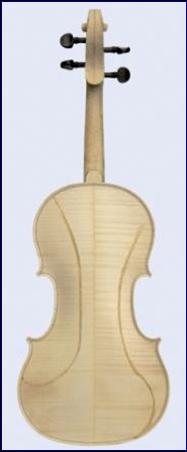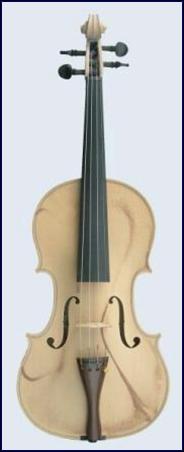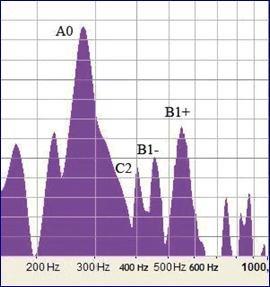
|
Violin modes B1- and B1+ |


|
Ease of emission and purity of the violin’s sound depend mainly on the delta between modes B1- and B1+.
Neck, varnish, fingerboard and chin rest modify the B1- and B1+ frequencies.
After the violin has been set up in the white for the first time, the back plate usually becomes deformed.
It is essential to wait approximately 30 days for the B1- and B1+ mode frequencies to stabilize at their true values, and only then proceed with their final tuning before varnishing the instrument.
The tone of a violin is based on four deltas
¨ delta of 20 to 30 Hz between coupling frequency (back and top plates) ¨ delta of 75 to 95 Hz between modes B1+ and B1- ¨ delta of 60 to 90 Hz between modes B1+ and A1 ¨ delta of 0 to 16 Hz between modes A1 and B1–
The final tuning of the B1- and B1+ mode frequencies must be conducted only on the violin set up in the white with its definitive chin rest. Page 7
A G-string playable on the full length of the fingerboard of a new instrument (a privilege of the great Italian violins): the acoustic result sought in this method, has been achieved.
Changing the chin rest will modify the B1- and B1+ mode frequencies and their delta.
Tuning B1- and B1+ mode frequencies to the critical limit requires perfect knowledge of the constraints related to moisture content in the wood, drying time, creep, varnish, and accessories, as well as considerable experience in making back plates, which must have sufficient resistance to avoid abnormal deformation that will render the violin useless.
The B1- and B1+ mode frequencies (for old or new instruments) published by researchers fail to take into consideration the moisture content in the wood at the time the readings were made.
In plates of 150- to 300-year-old instruments, the frequency spread is less (the moisture content in the wood rarely exceeds 8%).
Without dehydration before assembly, once the wood dehydrates for the first time to between 2.5% and 0% moisture content, the plates (top and back, in the white or varnished) will retract and their frequencies will no longer return to their initial position. If the B1- and B1+ mode frequencies are above the critical limits:
the violin’s sound will be unsuitable for classical music; the B1- and B1+ mode frequencies can shift after the instrument has been varnished; the delta between these two modes can be as great as 120 Hz; the sound will be poor and harsh.
Regressions concerning mode frequency readings on different violins (old or new) are valid only for a determined moisture content that is identical for all the instruments under comparison. Whether the readings are taken at 1-month or 10-year intervals, they must be done with the same moisture content in the wood for the top and back plates.
In order to predict the B1- and B1+ mode frequencies of a violin in the white with a margin of error of +/- 3 Hz, the wood’s moisture content of the moment must be known. Each change in the moisture content of the wood modifies all of the violin’s mode frequencies. The latter follow the curve representing the moisture content in the wood, which, in turn, follows the curve plotting the ambient relative humidity in the workshop.
Setting up the violin in the white
A violin must be set up in the white, for it is essential to know the height of the B1- and B1+ mode frequencies, and the delta between them, before varnishing the instrument.
The top plate is the motor of the violin, giving it dynamics, whereas the back plate gives it power. Both parameters are determined by the B1- and B1+ mode frequencies. According to their pitch, these frequencies can worsen or improve the instrument’s sonority.
Retuning frequencies of the mode B1- and B1+ on a violin in the white
The back plate’s B1+ mode frequency can be higher than expected, due to several causes:
· Insufficient density or elasticity with insufficient thickness in the “C”s or the central region; · The back plate yields to pressure from the sounding post, thus raising B1+ ;
· The free back plate was tuned based on an erroneous figure for the moisture content in the wood;
· Forcible mounting of the back plate on the ribs whilst the edges were curled up;
· The sound post was forced in too tightly, deforming the arch of the back plate.
Whatever the quality of the materials and of the outcome, it must be assumed that, sooner or later, all violin back plates will become deformed (0.5 to 2 mm) until they attain their definitive stability (depending on the back plate’s resistance).
The B1- and B1+ mode frequencies must be checked: first without, then with a chin rest, choosing the most suitable one, for it can lower these mode frequencies sufficiently to make sanding unnecessary on the extrados of the back or top plate in order to tune them.
The B1- nodal lines should be activated on the top plate “with a sound post” in order to avoid confusion with the A1 mode frequency. The B1- reading taken on the top plate will be the sole reference.
Setting the neck and gluing the fingerboard do not modify the mode B1- frequency.
After the top plate has been glued, the B1+ nodal lines visible on the back plate change shape permanently. The B1+ nodal lines previously seen on the extrados of the back plate glued to the ribs without the top plate are no longer visible.
On a good violin in the white, you should hear harmonics within the body with reverberation. You should also hear the sound of the wood, characteristic of fine Italian violins. This particularity disappears if the sealant or varnish is inappropriate.
N.B. Correctly tuned mode frequencies ensure that the violin will be very good, but they never provide an exact indication of the instrument’s true acoustic qualities, which depend on the characteristics of the wood used, the quality of the work and the varnish. The instrument must be played by the violin maker and by a professional to have an objective point of view.
The technique for tuning back and top plates is simple in itself; the main problem remains When the wood absorbs moisture, hysteresis in the frequencies will be observed on a violin in the white. Mode frequencies B1- and B1+ first rise, and then fall when the moisture content in the wood reaches equilibrium. The reverse occurs when wood loses moisture.
Dehydrating the materials is a necessity to obtain a violin with high and stable performances. Lengthy exposure of the materials to sunlight requires time and favorable weather conditions, which are not always available. UV exposure yields good results and offers the advantage of year-long availability. Kiln drying is only one of many techniques to improve the performance of materials.
Only modes B1- and B1+ function as a coupled resonator. The back and top plates become deformed in opposition of phase (a push-pull or “breathing” motion) interact on the A0 cavity mode. The modes interact in groups of two or three. Therefore, it is important to know the position of the frequencies of each mode and delta.
A difference (say, 5 Hz) in the coupling frequency of the top or back plate generates a progression in the frequencies for modes B1-, and B1+ of twice that value (i.e. 10 Hz, in this example). Mastery of this tuning technique allows the violin maker to impose his/her preferences as to the timbre, dynamics, and power of the instrument. The outcome of coupling the top and back plates on the ribs in an unheated workshop with materials that are highly sensitive to humidity and therefore unstable–will be terrifically complex.
The sounding box of a violin in the white can swell or retract dramatically, thus modifying the A0 cavity frequency with a sound post as well as the A1 mode frequency.
The neck (coupled with a fingerboard or not) will modify the mode B1+ frequency until the final setting of the strings. The B1+ mode frequency will fall back down to its normal value when the B0 mode frequency is tuned between 268 Hz and 276 Hz. When mode B0 exceeds 290 Hz, the B1+ mode frequency will be above its normal value.
A violin is an ensemble of coherent parameters. If a single element is faulty, the whole will suffer from that one defect. All the frequencies of the sounding box are very closely related to each other. Certain sounding box frequencies will act jointly, depending mainly on the height of the frequencies, but also on the frequencies of their octaves (multiple or sub-multiple). When these octave frequencies are concordant (± 5 Hz), they confer additional richness to the instrument's tone.
The clarity of the timbre is first and foremost conferred by the height of the top plate’s coupling frequency. The sensation of a clear timbre is intensified by the height of the A0 and A1 mode frequencies as well as that of the B1+ mode frequency. If the combination of these three frequencies is too high, the violin will be at the point of saturation. Dynamics and power combined will be too great for a violin bow, and vibrato will be very difficult to obtain. Greater pressure on the bow will be required to prevent the hair from slipping on the strings, further saturating them.
The acoustic signature of a violin is variable, for it follows the curve representing the moisture content of the wood in the white or varnished.
When proper consideration has not been taken of the back plate’s characteristics (the density and elasticity of the wood), deformation of its arch will be observed: it rises under the pressure from the sound post, which itself receives pressure from the strings (12 to 15 kg or 26.5 to 33 pounds). A new violin that sounded very good can become unplayable.
This problem occurs when thickness is insufficient at the center of the plate and especially on the edges of the C-bouts on very low-density wood with very low elasticity. The same phenomenon occurs on medium- or high-density wood where thickness is insufficient to obtain an appropriate free back plate frequency.
It is very easy to retune the B1- and B1+ mode frequencies by sanding the extrados (outer surface) of the back or top plate in the white, removing very little wood.
This amounts to using the method used by the Cremonese violin makers, who first tuned the free materials, then inlaid the purfling, and finished the purfling channel on the sounding box. This process also lowers the frequency of the materials (both free and mounted on the ribs) as well as the B1- and B1+ mode frequencies, which enabled the old masters to finalize tuning after the materials had been left to stabilize for a while.
Comments
The method explained in this book enables the reader to understand and learn the tuning technique used by Stradivari, Guarneri, and other Italian makers, but with recourse to modern devices so as to avoid those failures due either to a bad choice of materials, or to a rapid change in moisture content of the wood during the tuning process.
The literature claims that the frequency of free back and top plates is tuned between 350 Hz and 370 Hz and that the frequency readings in question have been taken on violins by Stradivari and Guarneri.
Ignorance of the materials' moisture content corresponding to said frequencies has created a persistent misunderstanding along with contradictory debates among contemporary violin makers and researchers regarding the veritable free top and back plate frequencies of Italian violins, as well as modes C2, B1- and B1+.
It is impossible for a maker to obtain satisfactory results if he/she tunes a free top and back plate in the white between 350 Hz and 370 Hz using materials that register 12% moisture content.
Each change in the moisture content in the wood of a violin in the white modifies the mode frequencies. This instability is due to a constant exchange of water vapor between the wood and the surrounding air, which likewise produces hysteresis of the frequencies.
When the moisture content in the wood exceeds 8%, its distribution throughout the materials is no longer homogeneous; the B1- and B1+ mode frequencies become disassociated from their coupling frequencies.
To an uninformed violin maker, the mode C2, B1-, and B1+ frequencies will appear incoherent, aleatory, and unrelated to the coupling frequencies and those of the free materials. Such is the problem in tuning back and top plates in the white in countries with temperate climates.
Thorough comprehension of the phenomenon of frequencies that rise, fall, and shift –following the curve representing the moisture content of the materials in the white, which similarly corresponds to the curve tracing ambient humidity in relation to air temperature– can be gained only by observing the behavior of the materials (several free top and back plates in the white, several violins, both in the white and varnished) over the course of one or more years, depending on the climatic conditions of the place where the instruments are made and stored.
The important influence of moisture on the frequencies of the materials can be quickly demonstrated by moistening the intrados and extrados of a violin plate (top or back) in the white with a sponge.
In order to obtain an instrument that is perfectly balanced when played, easily emits a pure, bright sound, with strings responding to the slightest solicitation and offering good resistance to the bow’s attack without saturation, the delta between the coupling frequencies of the top and back plates must be neither less than 20 Hz nor greater than 30 Hz, such that the delta between modes B1- and B1+ is neither less than 75 Hz nor greater than 95 Hz.
307 308
Photo 307. On a violin in the white, without a sound post and without strings, the A0 mode frequency peak is always the highest one.
Photo 308. However, on a violin set up in the white or varnished, it is the B1+ mode frequency peak that is always the highest.
N.B. The violin must be varnished only after the back plate has reached its critical limit
Copyright © 2010 - 2023 Patrick Kreit Reproduction of any content of this site without my express written permission is prohibited.
|
|
Mode B1- = corpus mode (Body one minus or T1). Concerns only the top plate (timbre - dynamics). It depends on the height of the top plate’s coupling frequency and moisture content in the material at that very moment. This radiant mode is important for the tone of the violin. This frequency can be identical to that of mode A1; their nodal lines overlap. |
|
Mode B1+ = corpus mode (Body one plus or C3). Concerns only the back plate (power). It depends on the height of the back plate’s coupling frequency and moisture content in the material at that very moment. This radiant mode is important for the tone of the violin.
(The nodal lines (sand) of the B1- and B1+ modes are activated with a frequency generator) |
|
What are modes B1- and B1+ in violin making? |

